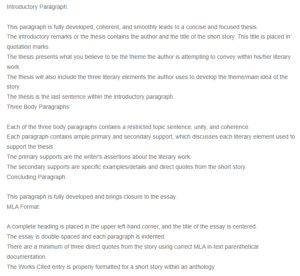Literary Analysis Essay – Sonny’s Blues
Introduction
Sonny’s Blues by James Baldwin is a short story about the recollections of a black man working as an algebra teacher in Harlem and his reaction to his brother’s arrest, drug addiction, and recovery. The story is set in the 1950s and focuses on the difficult lives of African Americans living in Harlem during the 1950s and their struggles dealing with rage, violence, and drugs. The story also demonstrates how hard it was for African Americans to leave Harlem despite having the desire to leave. The central theme in James Baldwin’s “Sonny’s Blues” is suffering, developed using various elements, including darkness, drug addiction, and the physical environment in Harlem.
The Theme of Suffering in Sonny’s Blues
Suffering is evident in the characters’ lives in Sonny’s Blues and motivates them to pursue a better life. Baldwin states, “I feel like a man who’s been trying to climb up out of some deep, real deep and funky hole and just saw the sun up there, outside. I got to get outside” (6). This statement suggests that Baldwin’s suffering was pushing him to seek an opportunity to get out of his dark life. The statement also suggests that Harlem was a trap limiting most people from living happy lives. The main reason it would have been hard for the people in Harlem to change their physical environment and move to another neighborhood was that the darkness in their lives pushed them to drug addiction and violence. For example, the disappointment of being unable to leave Harlem could have led to drug addiction. Therefore, although suffering motivated the people in Harlem to look for a better neighborhood, they remained trapped in Harlem because the physical environment pushed them into darkness.
The physical environment in Harlem is the leading cause of suffering in the area because it changes people’s feelings and their efforts to find happiness. Baldwin states, “I saw the moonlit road where my father’s brother died. And it brought something else back to me, and carried me past it, I saw my little girl again and felt Isabel’s tears again, and I felt my own tears begin to rise” (32). This statement suggests that Baldwin’s sadness was created by seeing the moonlit road that reminded him of the death of his father’s brother. The statement suggests that changing the physical environment could have helped Baldwin avoid negative memories that impacted his efforts to escape his suffering. For example, if he had not seen the moonlit road, he would not have remembered his father’s brother’s death and his sad past when his little girl was crying. Therefore, the physical environment in Harlem trapped people in darkness by constantly reminding them of their sad memories.
Drug addiction was the main escape for the people experiencing suffering in Harlem. Baldwin states, “When she was singing before,” said Sonny abruptly, “her voice reminded me for a minute of what heroin feels like sometimes it’s in your veins. It makes you feel sort of warm and cool at the same time. And distant. And- and sure” (25). This statement suggests that drugs such as heroin were being used in Harlem to escape the darkness and suffering in the physical environment. For example, using heroin enabled those suffering to feel good, forget about their problems for a while, and distance themselves from the physical environment causing their suffering. Drugs were also used to deal with the frustrations of being unable to get out of the darkness and suffering in Harlem. Therefore, drug addiction was almost inevitable in Harlem because it helped people cope with the darkness in their lives and get out of the physical environment causing suffering.
Conclusion
Sonny’s Blues highlights the theme of suffering by focusing on the main drivers of suffering in Harlem, including the physical environment, drug addiction, and darkness. The author demonstrates the relationship between the physical environment, darkness, and drug addiction in Harlem, which made it hard for people in Harlem to find happiness and leave Harlem. For example, drug addiction relieved people in Harlem from suffering by making them forget about the darkness in their lives and escape their physical environment. However, suffering is necessary to push the people in Harlem to seek a better life outside Harlem.
Works Cited
Baldwin, James. “Sonny’s Blues.” Google, docs.google.com/viewer?a=v&pid=sites&srcid=Zmxocy51c3xzdW1tZXJ8Z3g6NGQ5ZDY0M2U4YzkwZDliNQ. Accessed 5 June 2023.
ORDER A PLAGIARISM-FREE PAPER HERE
We’ll write everything from scratch
Question

Literary Analysis Essay – Sonny’s Blues
Introductory Paragraph:
This paragraph is fully developed, coherent, and smoothly leads to a concise and focused thesis.
The introductory remarks or the thesis contains the author and the title of the short story. This title is placed in quotation marks.
The thesis presents what you believe to be the theme the author is attempting to convey within his/her literary work.
The thesis will also include the three literary elements the author uses to develop the theme/main idea of the story.
The thesis is the last sentence within the introductory paragraph.
Three Body Paragraphs:
Each of the three body paragraphs contains a restricted topic sentence, unity, and coherence.
Each paragraph contains ample primary and secondary support, which discusses each literary element used to support the thesis.
The primary supports are the writer’s assertions about the literary work.
The secondary supports are specific examples/details and direct quotes from the short story.
Concluding Paragraph:
This paragraph is fully developed and brings closure to the essay.
MLA Format:
A complete heading is placed in the upper left-hand corner, and the title of the essay is centered.
The essay is double-spaced and each paragraph is indented.
There are a minimum of three direct quotes from the story using correct MLA in-text parenthetical documentation.
The Works Cited entry is properly formatted for a short story within an anthology.

